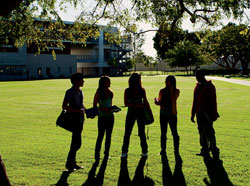sierraclub.org - sierra magazine - sept/oct 2012 - college town
College Town
 iStockphoto/MichaelDeLeon
iStockphoto/MichaelDeLeonThis spring, as final exams tormented students nationwide, I wandered the college and the town of Oberlin, in Ohio, with Professor David Orr. The scent of cut grass wafted through trees that seemed to have reached some vital green peak of the photosynthesis cycle. Amorous birds yodeled, and students snatched kisses. It was enough to make a skeptical journalist believe that anything is possible.
More than any other subset of our culture, college students get that the world has problems that urgently need fixing. Knowing what they do about climate disruption, they smell wildfire smoke, or brace against hurricane winds, or watch droughts turn fields to jigsaw mud with increasing concern about their own futures. And if anyone has an obligation to hear the students' logical worries and shepherd them toward solutions, it's the professors and administrators at the colleges those smart kids attend.
This "Cool Schools" issue is Sierra's sixth annual effort to assay how well colleges and universities across the United States are taking these ever-growing environmental challenges into account when they design and redesign their campuses and their practices. The progress being made is hugely encouraging.
What interests me about Orr, who helped launch the whole college sustainability effort 20 years ago, is that he now finds that initiative almost tragically unambitious.
A trend among U.S. colleges and universities is to move away from the cloistered, Jeffersonian campus—what architect Robert A.M. Stern called "a place apart"—and toward an embrace of the communities that contain them. Sharon Haar, an associate professor of architecture at the University of Illinois, Chicago, fleshes out that idea in her book The City as Campus. From Harvard to Ohio State, universities are involving themselves in shaping adjacent towns and asking their nonacademic neighbors to engage with them.
Orr's question, to paraphrase provocatively, might be: "What's the point, so long as the buildings and policies you're designing, and the economies you're helping to shape, and the students you're supposedly preparing, fail to grapple effectively with the greenhouse-gas emissions that will doom all of those enthusiastic, optimistic young scholars to diminished lives?"
If Orr has his way, more colleges and communities will team up to address these global environmental questions on a local level and take pride in the ripple effect. In any case, all of those sustainability officers who grumble about completing our admittedly time-consuming survey should anticipate even tougher questions in coming years about how their schools are showing environmental leadership. Sierra will be asking, and so will their students.
Meanwhile, any reader who thinks it's too much for Americans to ask their universities to step up and protect the planet may want to read about the unschooled women who are doing their part to address both local pollution and climate disruption at India's Barefoot College. —Bob Sipchen, editor in chief